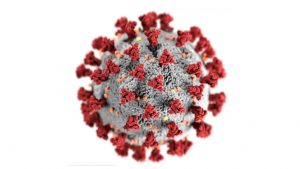After more than three years, the global coronavirus disease 2019 (COVID-19) emergency is officially over. Yet it’s still killing at least one person every four minutes and questions on how to deal with the virus remain unanswered, putting vulnerable people and under-vaccinated countries at risk.
A key question is how to handle a virus that’s become less threatening to most but remains wildly dangerous to a slice of the population. That slice is much bigger than many realize: COVID is still a leading killer, the third-biggest in the US last year behind heart disease and cancer. Unlike with other common causes of death such as smoking and traffic accidents that led to safety laws, though, politicians aren’t pushing for ways to reduce the harm, such as mandated vaccinations or masking in closed spaces.
“The general desire in the world is to move beyond the pandemic and put COVID behind us, but we can’t put our heads in the sand,” said Ziyad Al-Aly, director of the Clinical Epidemiology Center at the Veterans Affairs St. Louis Health Care System in Missouri. “Covid still infects and kills a lot of people. We have the means to reduce that burden.”
Even before the World Health Organization declared earlier this month that Covid no longer constitutes an emergency, most governments had already relaxed lockdowns and guidelines. After spending heavily in earlier phases of the pandemic, global leaders have dialed back efforts and are reluctant to pursue preventative measures for which the public no longer has much patience.
Meanwhile, the infection that caused at least 20 million deaths worldwide continues to evolve, leaving the elderly and those with pre-existing conditions at the mercy of luck, uneven access to medicine and little protection from others without face masks or recent vaccinations.
NO LONG-TERM PLAN?
A global, long-term plan to protect the vulnerable and to keep a resurgence at bay hasn’t materialized, partly because of how difficult it is to forge any consensus around Covid. From the start, polarized political discourse overshadowed official guidelines on masking and vaccinations.
Even in developed countries where the vaccine became available in less than a year into the pandemic, many people refused to take it. Lack of immunization led to more than 300,000 excess American deaths, or one out of every two from Covid, throughout 2021. Globally, it could have saved half a million more, studies show.
“We know that politicizing public health is one of the tragedies of the pandemic,” Ziyad Al-Aly said. “Political leaders leveraged their responses not only to advance public health but to advance their own narrative and drum up support for themselves.”
Global coordination has also been hampered by politics. China’s refusal to allow independent experts unfettered access to a wet market thought to be a crucible for Covid or to the Wuhan Institute of Virology added to diplomatic tension and mistrust. Today, Chinese representatives aren’t participating in many global preparation efforts, said Linfa Wang, a virologist and director of the emerging infectious diseases program at Duke-NUS Medical School in Singapore.
“It’s hindering academic collaboration, and China/US collaboration is almost zero,” Wang said. “With these two superpowers, if they don’t collaborate, how can we say the world is ready for the next disease?”
A waning sense of emergency has also meant the surge of investment in COVID vaccines and therapeutics has also cooled. While companies including Moderna, Inc. and Pfizer, Inc. are still updating their shots, trying to make them easier to manufacture and store, many of the hundreds of novel approaches that were initially conceived have fallen by the wayside.
In the US, experts are due to meet in June to advise on what strain of the virus vaccines should target for the remainder of the year. Those vaccines will only launch in the fall, with just 100 million doses expected in the US according to Moderna’s estimates, far less than in previous years.
WHY IS THIS A PROBLEM?
Long COVID, estimated to affect around 10% of infected people, is considered one of the biggest post-pandemic medical challenges. The economic costs are also significant.
In the US, long COVID was estimated to cost around $50 billion a year in lost salaries as of late 2022. In the UK, the Institute for Fiscal Studies last year estimated that about one in 10 people with long COVID have to stop working as a result. The number of people with those symptoms, including brain fog, breathing difficulties and fatigue, are rising even as infections are decreasing.
It’s particularly scary for high-risk people, who’ve had to return to work and public spaces where masks are sparse, and the dangers are invisible. A family wedding can still turn into a super-spreader event, and a flight can be catastrophic.
While people with active health issues may know to take precautions, some will learn that they’re vulnerable only after an infection lands them in the hospital. Repeated bouts can add to damage, and that applies to everyone, not just those with pre-existing conditions.
WHAT TO DO
The silver lining is that the world now has vaccines and better treatments. Tests can uncover infections in minutes, and new outbreaks can be quickly spotted.
Health experts say immunization is the best way to protect against it. Only about 16% of Americans have gotten a bivalent booster, according to Pfizer, Inc., compared with almost 70% vaccinated in the first inoculation drive. Increased out-of-pocket costs and vaccine fatigue could cause uptake rates to fall further. Longer term, the hope is that innovative new shots or nasal sprays will provide better protection.
There are other improvements that could help, ranging from ventilation and air quality testing to better masks. There needs to be more investment in surveillance systems so threats can be caught early, experts said.
The US is also planning to spend $5 billion on a new project aimed at developing advanced vaccines and treatments for coronaviruses in concert with drugmakers. The goal is to make medicines available quickly as the virus mutates, so the targeted strain isn’t ebbing when they hit the market.
“Even if governments are tired, we have to face the reality that the virus is still evolving,” said Duke-NUS’s Wang. — Bloomberg























